What Are Monsoons and Why Do They Happen?
On the evening of June 11, 2015, it began to rain in Mumbai, India, and it did not stop until the next day. Trains were delayed. A wall collapsed with the added weight of water. Notices were posted about the risk of landslides in hilly areas of the city. Two people died as a result of the rainfall. Yet there was a feeling of relief in the city. As a news article in the New Indian Express put it, “Mumbai smiled as heavy showers lashed the city.”
The city was smiling, so to speak, because this storm ended a long heat wave. Before the rain began, it was so hot during May that asphalt roads were melting. In many places in India, humid conditions made the heat feel much hotter. In one location, the heat index, which takes both heat and humidity into account to describe how hot it feels, was over 140°F (60°C). After the rain started, temperatures dropped as clouds shaded Mumbai from the sweltering sun. It was still warm — with high temperatures above 80°F (27°C) — but was much cooler than during the heat wave. The start of rains in early June marked the end of the dry winter and the onset of the wet summer monsoon.
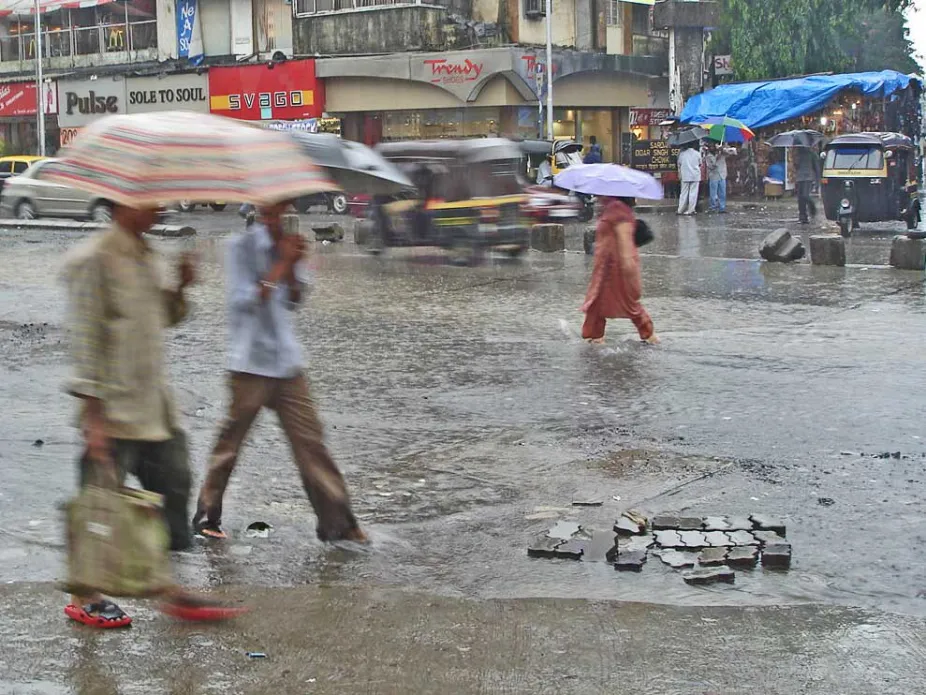
Mumbai, India, during monsoon rainfall.
Indrani911basu
Monsoons produce the very wet summers and dry winters that occur on nearly all of the tropical continents. A monsoon is not a storm like a hurricane or a summer thunderstorm, but a much larger pattern of winds and rain that spans a large geographic area like a continent, or even the entire globe.
Weather and climate are very different in the tropics and mid-latitudes, and it is not just a matter of the tropics being warmer. In Europe, North America, and other mid-latitude regions, temperatures undergo large changes over the seasonal cycle, and weather events in these regions last a few days as high- and low-pressure systems drift slowly eastward, rearranging the locations of warmer and colder air masses as they go. This might make it cool and rainy one day and warm and sunny the next. In contrast, tropical temperatures don’t change much throughout the year. The seasonal cycle over tropical continents is marked by an oscillation between dry and wet periods brought about by monsoons. Weather events in the tropics, such as typhoons, thunderstorms, and other rainstorms, are actually embedded within the much larger monsoons. Billions of people live in the monsoon climates of South Asia, Africa, and the tropical Americas, and every spring they wait for the monsoon rains that will end the winter dryness even though they might also cause disastrous floods. There is often too little water or too much.
Where Monsoons Are Found
If you are looking for monsoons, you’ll need to head to the tropics. That’s where rain is produced as warm and humid air rises in the Intertropical Convergence Zone (ITCZ), which swings north and south in a seasonal cycle, causing patterns of distinctly wet and dry seasons (explore the Why Monsoons Happen section below to learn more about how this works).
However, monsoons are not the same throughout the tropics, because the specific locations of continents and oceans influence the regional patterns of winds and rain. Classic conditions for strong monsoons are found where the Indian Ocean and the Pacific Ocean meet. This region includes India and South Asia to the north of the equator and Australia south of the equator. Strong swings between wet summers and dry winters are found in those places as the ITCZ moves back and forth across the equator. The South Asian monsoon, which includes the Indian monsoon, is especially strong because the Himalayas and other mountains block dry air in the north from getting to the humid monsoon region. The seasonally wet and dry region just south of the Sahara Desert in West Africa and the Sahel is another classic monsoon region. Monsoons occur in the Americas too, but tend to be weaker than in other regions.
The animated map below shows how precipitation varies through a typical year. Notice that most precipitation occurs in the tropics and swings north and south of the equator with the seasons. This seasonal shift in the location of tropical precipitation indicates a shift in the location of the ITCZ and is the reason why there are distinct wet and dry seasons on tropical continents.
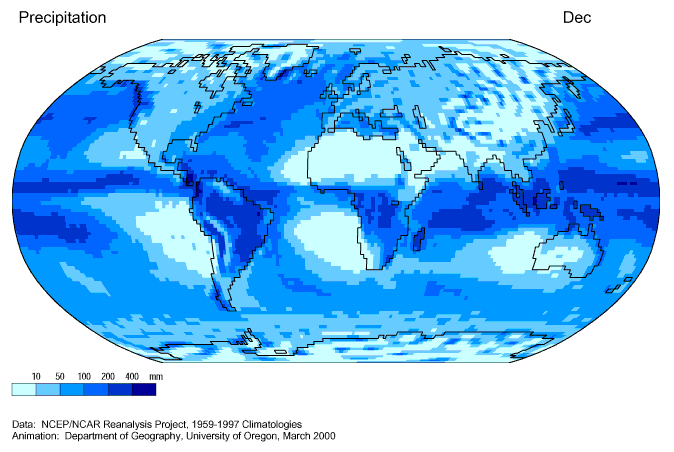
Patterns of precipitation through the year
University of Oregon
Asia, India, and Australia
With the world’s strongest monsoons, this region stretches from the South China Sea into the Indian Ocean and includes Asia and the northern end of Australia. From June until September, summer monsoon rains occur in South Asian countries such as Vietnam, Thailand, Cambodia, Bangladesh, Laos, India, and Pakistan. From December until February, the monsoon rains move south of the equator toward Australia while South Asia experiences dry monsoon conditions. There is even an East Asian monsoon that brings summer rain to China, Japan, and Korea, but it is caused by a different type of wind pattern that is associated with the jet stream.
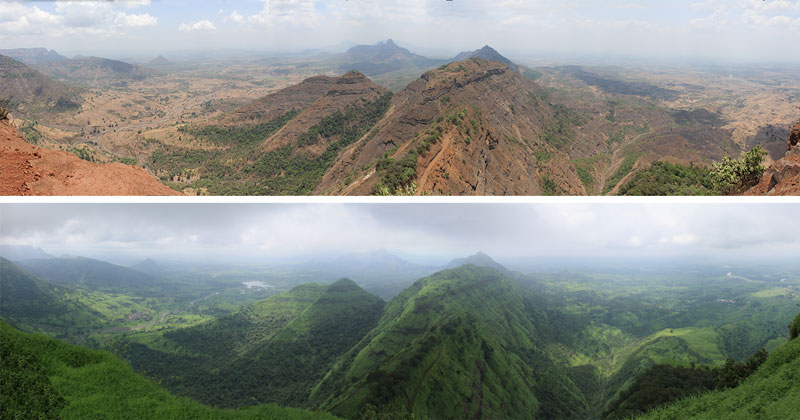
Monsoons bring large amounts of rain to a location, often leading to large-scale vegetation growth.
University of Oregon
The Americas
Monsoon winds in the tropical parts of North America, Central America, and South America cause the amount of rainfall to vary with the seasons, even in areas where precipitation is plentiful and rainforests thrive. From June to August, which are summer months in the Northern Hemisphere, there is more rainfall north of the equator in Costa Rica, Nicaragua, Panama, and western Mexico. From December to February there is more rainfall south of the equator in Brazil. The North American monsoon does bring moisture from the warm waters of the Pacific into the US Southwest, but its peak rainfall occurs in Mexico, and the US states of Arizona and New Mexico lie on its periphery. These areas are typically dry but can receive enough rainfall to quell a wildfire if moist monsoon winds blow in summer. An area of summer rainfall along the US East Coast is associated with what some might call a mid-latitude version of monsoon rainfall.
Africa
During Northern Hemisphere summer, the Intertropical Convergence Zone (ITCZ) over Africa lies far north of the equator, just south of the Sahara Desert in an area known as sub-Saharan Africa. Moist winds blow from the Atlantic and produce rain once they reach West Africa in countries such as Mali, Niger, Ghana, and the Ivory Coast. During Southern Hemisphere summer, the ITCZ lies south of the equator and brings rain to southern African countries such as Zimbabwe, Tanzania, Zambia, Malawi, Mozambique, and Uganda. Meanwhile, sub-Saharan Africa becomes particularly hot and dry in winter as air descends from high in the atmosphere to the ground as part of the Hadley Circulation.
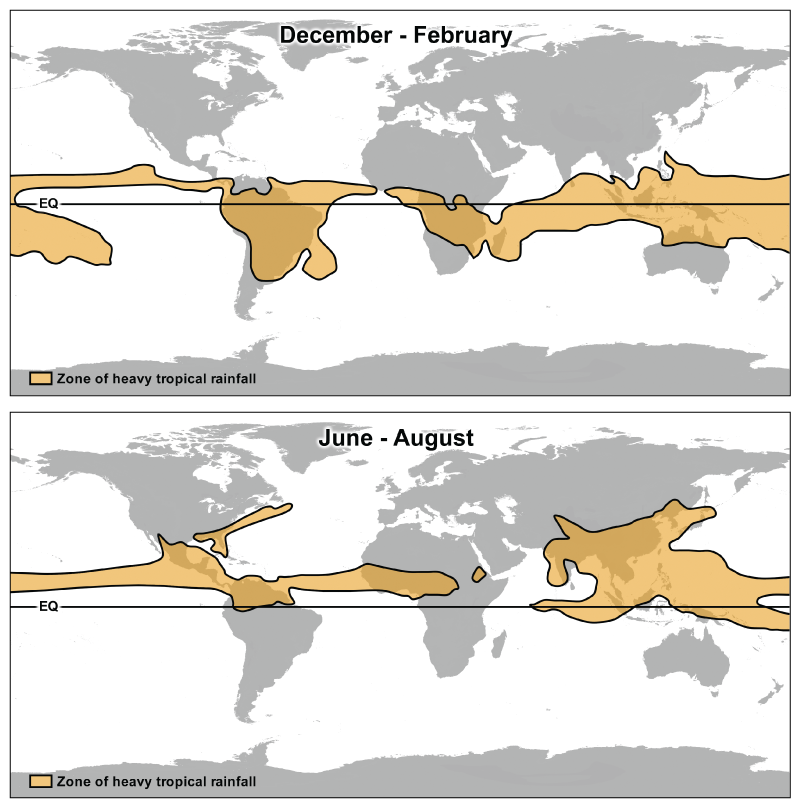
The locations of the heaviest tropical rainfall from December to February (top) and June to August (bottom).
UCAR
Why Monsoons Happen
"The monsoon winds have formally arrived in the city," Mumbai Regional Meteorological Centre’s Director-General V.K. Rajeev told the Indian press on Friday June 12, 2015, after a full night of rain.
He referred to winds even though people cared more about the rains that had just started. That’s because monsoon rains are controlled by the wind and, in general, by the way air moves through the tropical atmosphere, which changes dramatically at the beginning and end of every summer.
There’s a pattern to the wind.
Air moves through the tropical atmosphere in a pattern called the Hadley Circulation: warm air rises near the equator, flows toward the poles, and then descends back toward the Earth’s surface in the subtropics. The air flows along Earth’s surface from the subtropics toward the equator and then the loop starts all over again.
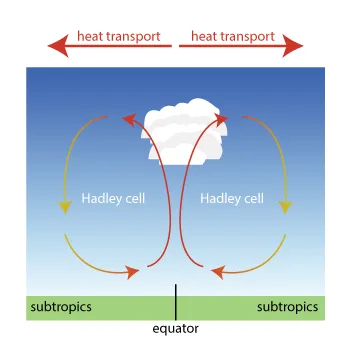
Air warmed in the tropics rises, flows towards the poles, then downward in the subtropics, and back to the equator.
UCAR
Sunlight, and the energy it brings to Earth, is the driving force behind the Hadley Circulation. Sunlight heats land and ocean surfaces near the equator. The warmed surface releases energy into the atmosphere, in the form of heat and evaporated water. Air that was warmed at the equator, and the water vapor it holds, rises and spreads out in the upper atmosphere, approximately 10-15 kilometers (6-9 miles) above the Earth’s surface. As it flows toward the poles, this air cools and drops down toward the surface of the Earth in the subtropics, near 30 degrees latitude north or south of the equator. As air rises near the equator and then flows poleward, it leaves an area of fewer air molecules at the equator. This is the ITCZ, a region of low pressure because there is a smaller mass of air left over the equator. Air from the subtopics north and south of the equator flows in to fill the space, completing the loop of Hadley Circulation. Water vapor condenses as air rises and cools in the ITCZ, forming clouds and falling as rain. The ITCZ can be seen from space as a band of clouds around the planet. This is where monsoon rainfall occurs.
If the Earth was not rotating, winds would blow directly towards the Intertropical Convergence Zone from the north and south. But the Earth is rotating — making a full turn on its axis each day — which turns the wind to the right in the Northern Hemisphere and to the left in the Southern Hemisphere. This means that air flowing toward the equator near Earth’s surface also flows toward the west, and makes up what we call the trade winds, which were important for global trade back in the days when goods were transported between continents by sailing ships. The effect of Earth’s rotation on the winds is called the Coriolis effect or Coriolis force. It also affects the movement of ocean currents and the direction of rotation in hurricanes. Motions that span hundreds to thousands of miles are affected by the Coriolis force. It does not impact smaller-scale phenomena like tornadoes. (And contrary to legend, the direction that water spins in a flushing toilet is due to toilet design, as toilets are much too small to be affected by the Coriolis force.)
The way the trade winds turned to the west on their way to the equator was of great interest to George Hadley, an 18th century British lawyer who dabbled in meteorology. He proposed that it was the spin of the Earth that caused the winds to turn as they blew toward the equator. He produced what was essentially the first global theory of atmospheric circulation. Over the years other scientists have refined and further developed these ideas, but Hadley did get some of the basics correct. Today, the Hadley Circulation in the tropics is named after George Hadley.
The Hadley Circulation doesn't stay in the same place year-round but varies with the seasons. This is the key to understanding why many tropical regions around the world have patterns of wet monsoon summers and dry winters. The seasonal changes in the Hadley Circulation create the world’s monsoons.
Winds change through the year.
During December and January, the Southern Hemisphere is heated more strongly by the Sun than the Northern Hemisphere, so the hottest air — the air that rises in the ITCZ — is found a little south of the equator. Winds from the Northern Hemisphere blow across the equator toward the ITCZ. During June and July, the Northern Hemisphere is heated more strongly by the Sun, so the ITCZ and its rising hot air lie a little north of the equator and winds blow from the Southern Hemisphere across the equator to reach the ITCZ in the Northern Hemisphere.
As the ITCZ changes location through the year, the winds and rains and the location of monsoon wet weather changes, too.
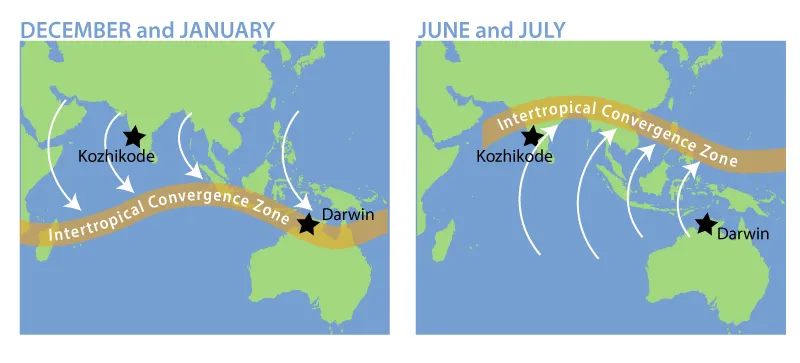
As the Intertropical Convergence Zone (ITCZ) changes location through the year, the winds, rains, and the location of wet monsoon weather changes, too. In this example from Asia and Australia, the ITCZ moves from the Southern Hemisphere (left map) to the Northern Hemisphere (right map).
UCAR
Remember that the Coriolis force changes direction on the equator: It turns winds toward the right in the Northern Hemisphere and to the left in the Southern Hemisphere. So when air crosses the equator as it flows from the cold winter hemisphere toward the ITCZ in the summer hemisphere, it experiences a change in the Coriolis force. This causes the trade winds to reverse direction and blow toward the west in the winter hemisphere and to the east in the summer hemisphere. This seasonal reversal of the winds was historically very important for trade between Africa and Asia. Ships would sail from Asia to Africa in winter and then undertake their return voyage when the summer monsoon changed the wind from westward to eastward.
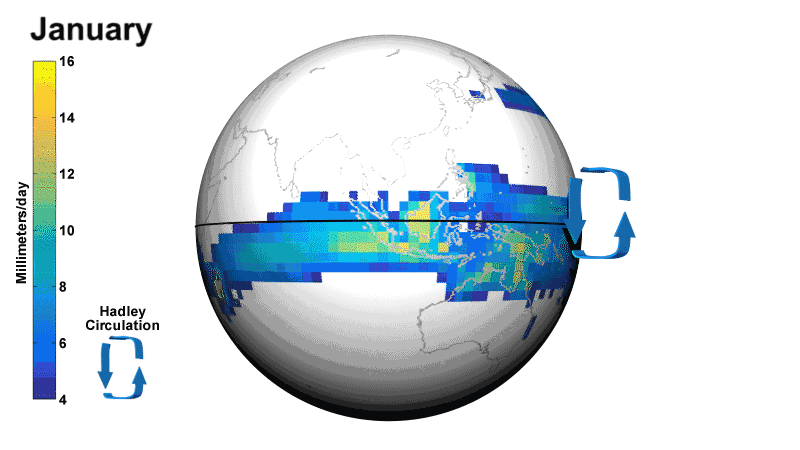
The animation above shows how the ITCZ, winds, and rain patterns change through the months of the year.
UCAR
The summer monsoon is what people often think of as monsoon conditions: large amounts of rain. But the winter monsoon, where dry conditions prevail, is part of the pattern too. During winter, air descends over tropical continents as the part of the Hadley Circulation that is outside of the ITCZ. Descending air causes high pressure and makes clouds and rain uncommon. The dry conditions during winter can even lead to drought if they are too intense or persist for too long.
Monsoons are affected by geography.
Geography affects the amount of rainfall that an area receives as the ITCZ moves through the seasons. For example, during Northern Hemisphere winter, the ITCZ is south of the equator and monsoon rains fall in northern Australia. Low-level winds blow south toward the ITCZ, picking up moisture as they move over the warm, tropical ocean. Meanwhile in India, dry air descending over land means there is little precipitation.
During Northern Hemisphere summer, the ITCZ is north of the equator and monsoon rains fall in India and other parts of South Asia as winds blow north from the tropical ocean to the land, while northern Australia experiences very dry conditions as air descends.
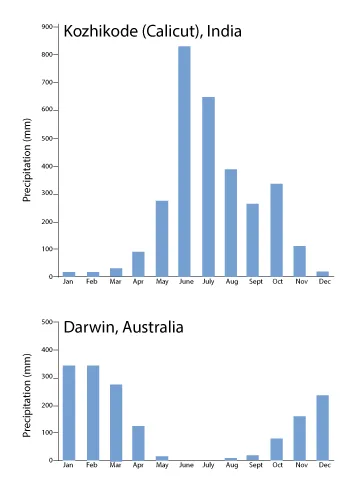
As the ITCZ swings north during the summer months, it brings monsoon rains to Kozhikode, India. As the ITCZ drops south during summer in the Southern Hemisphere, it brings monsoon rains to Darwin, Australia.
UCAR
The location of monsoon rainfall is affected by the fact that land can’t hold onto heat as well as the ocean. When intense summer sunlight hits land, its energy is absorbed and transferred quickly back into the atmosphere. When summer sunlight hits the ocean, the Sun’s energy is held by water and can be mixed downward and stored tens to hundreds of feet below the surface. This means that in summer, air over land is heated more than air over ocean, which shifts the ITCZ toward land regions. In regions where continents lie north or south of the equator, as in Asia and Australia, this causes the ITCZ to shift farther off the equator during the summer season.
What affects the amount of rain?
There is year-to-year variation in the amount of monsoon rainfall during summer. For example, researchers have found that during El Niño conditions, when the Pacific Ocean is particularly warm near the equator, there is typically less rainfall during the summer monsoon in India. During La Niña conditions, when the Pacific Ocean is cool, there is more rain during the summer monsoon in India. While this is a general pattern, it cannot be used to indicate exactly how much rain will fall in India in any particular summer. In fact, the strongest El Niño event in the 20th century (1997 - 1998) had little effect on the Indian monsoon. So, there must be other influences on the amount of rainfall, too. This is an area of active research.
Climate change may be changing monsoons.
According to most computer simulations of Earth’s climate over the next 50 to 100 years, there will be an increase in rainfall in most monsoon regions as climate warms due to the rising levels of atmospheric greenhouse gases such as carbon dioxide. Rains will likely increase in wet regions as the climate warms if the wind patterns do not change, because warm air can hold more water and more water vapor in the atmosphere will produce more rain in the ITCZ. Over ocean, where there is abundant water supply for the atmosphere, this is quite likely, but it is less clear how the amount of rain may change over land as the climate warms. Whether or not winds will change enough to have a large effect on the rainfall is also unclear. During the dry season, land is expected to become drier because evaporation from land will increase in a warmer climate.
At the same time that rainfall is changing due to global climate change, natural year-to-year variability is happening as well. Other changes to the amount of rainfall may be caused by air pollution (such as tiny particles released as coal, oil, and gas are burned). The amount of monsoon rain that falls each year is highly variable, according to records of rain in India collected since the 1880s. In parts of India monsoon rainfall has decreased since 1950. Meanwhile, in the Philippines and other areas of the western North Pacific, the amount of monsoon rain has increased. Weak monsoon rains produced drought and famine over large parts of Africa in the 1970s and 1980s, but the West African monsoon rains have recovered somewhat since then. So there is evidence that monsoons are changing, but researchers are still investigating how the amount of monsoon rainfall will be affected by climate change in the future.
Monsoons Impact People
Impacts on agriculture and economy
Farmers in monsoon regions rely on the wet summer months to grow crops. However the summer monsoon does not always bring the same amount of rainfall, and variations in rain have implications for agriculture and the economy.
For example, in 2009, very little rain fell during the summer monsoon in India. In some areas rainfall was half of what is typical during the wet season and farmers could not plant their crops. Farm animals starved; many were sold for a fraction of what they would have normally been worth because farmers were desperate.
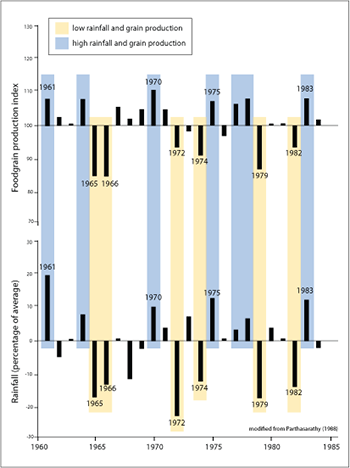
From wheat and rice to vegetables, cotton, and tea, Indian farmers grow a wide range of crops and the country uses more land for crops than any other country in the world (215 million acres, or 87 million hectares). Crops depend on rain and, in India, more than three quarters of the annual rainfall occurs during the four months of the summer monsoon season. But during years when there is less rainfall than usual, crops die in the fields or cannot be planted at all. The graph at the left shows how the amount of grain crops produced by farmers in India (including wheat, rice, and barley) relates to the amount of rainfall. Over half of India’s population works in agriculture, and monsoon rains directly affect their incomes and livelihood. Agriculture adds up to more than 15% of India’s Gross Domestic Product (GDP), which means that when crops fail because of too little rain, the economy suffers.
While too little rainfall during the summer monsoon can cause dire conditions for farmers on land, too much rainfall and overly strong winds can make coastal waters unsafe, preventing fishermen throughout South Asia from heading to sea to catch the fish they depend on for income.
Monsoon rains can be harnessed as hydropower, a valuable energy resource. Hydropower currently provides 25% of India’s electricity. Reservoirs are filled during the summer monsoon rains and then the water is gradually released through dams, turning turbines to create electricity year-round. During years when there is little monsoon rainfall, the reservoirs are not replenished, limiting the amount of hydroelectric power produced during the year.
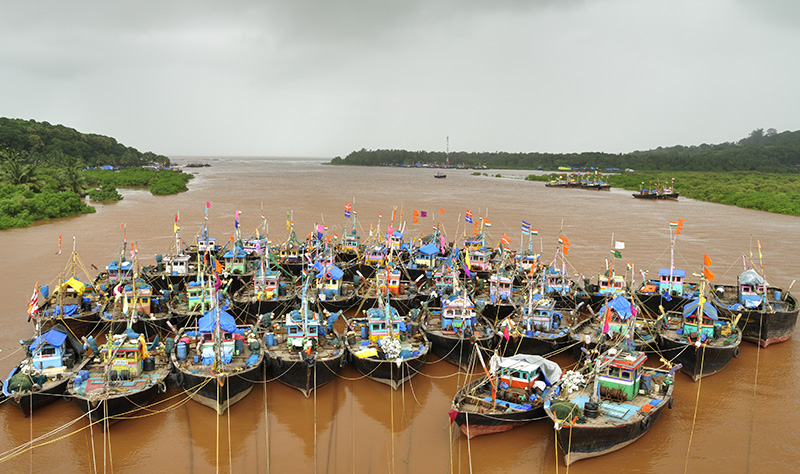
Fishing boats in South Asia
Sandip Dey, Wikipedia Commons
Monsoons and health
Because regions with a monsoon climate have distinctly wet and dry seasons, they are prone to floods and droughts, both of which are hazardous to health.
During summer monsoons, heavy rainfall can cause flooding. Powerful floodwaters can drown victims and damage buildings, leaving people without homes and vulnerable to the elements. During the 2014 summer monsoon in Pakistan and India, nearly 300 people lost their lives because of landslides and home collapses. Australia’s 2011 monsoon flooding caused about US$4.5 billion in damage.
Yet the main health hazards during summer monsoon season are diseases like cholera, dengue, chikungunya, and malaria, as well as stomach and eye infections. Each year, as the summer monsoon season approaches, Indian hospitals prepare for high numbers of patients with these illnesses.
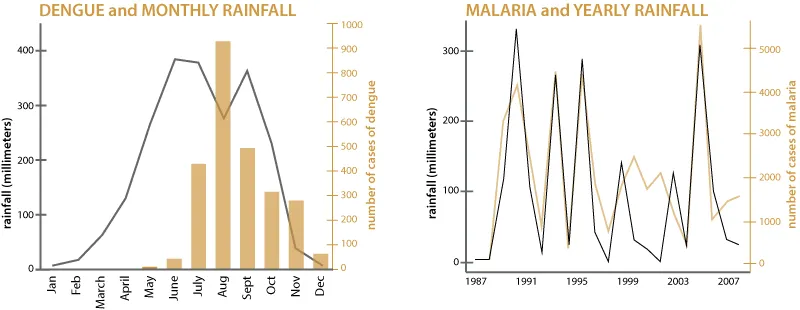
(left) During months with less rainfall in Bangladesh, there is less dengue. (from Karim et al, 2012). (right) Years with heavy rainfall in India tend to have more malaria cases
Magori and Drake, 2013
When floods cause water purification systems to become compromised, diseases like cholera can spread through unclean drinking water. Also, mosquitos that carry disease breed in open containers that fill with rainwater — from large water barrels and ponds to small coconut shells. Mosquitos that spread malaria, dengue, and chikungunya are common in the tropics. Because mosquitoes have more places to breed during the summer monsoon rains, there are more mosquitos. That leads to more mosquito bites that spread disease.
During the winter, clouds rarely provide shade and the dry land surface can’t cool off by evaporation, so heat waves are common. At least 2,500 people died in a major heat wave that swept across India in 2015, and over 1,000 died about a month later from a heat wave in Pakistan. Temperatures in New Delhi were near 120°F (almost 50°C). Water is scarce at this time of year, which causes water-washed diseases to become common; these diseases spread when there is too little water for proper hygiene.
Meningitis, which kills one in ten victims, spreads during the dry season in sub-Saharan Africa when desert dust becomes airborne and is inhaled. Typically the number of cases drops with the first monsoon rains.
The number of people affected by both the wet and dry monsoon seasons depends on the population of the affected region. For example, Mali in West Africa has a fast-growing population and researchers are investigating how people will cope with the same limited water resources during the dry season as the country’s population grows.